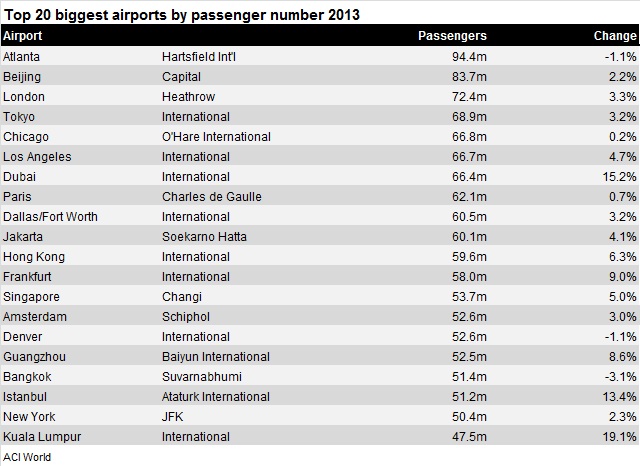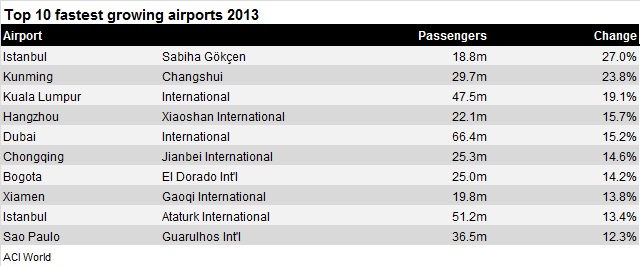Preliminary traffic figures from ACI World show airports handled 4% more passengers in 2013 than the previous year, though the top 150 airports grew at a slightly faster rate.
The figures, based on preliminary data for more than 1,100 airports in 2013, show passenger growth of 4% and international passengers more than 5% higher. This increase came despite an only negligible increase in aircraft movements during the year.
Analysis of the 150 biggest airports shows a faster rate of growth, passenger numbers at these airports rising 4.4% in 2013 to 4.04 billion.

Asia Pacific airports now represent the largest share of passengers among the leading 150 airports. Asian airports among the biggest 150 in the world account for 1.31 billion passengers, as these airports handled 7.4% more people than in 2013 to reach 1.31 billion. In 2012 Asia-Pacific airports accounted for 1.15 billion passengers among the top 150 airports.
It means the region surpasses North American as the biggest for passenger numbers among the leading 150 airports. Tight capacity discipline in the North American airline sector was reflected in growth of just 1.6% among the leading US airports in handling 1.24 billion passengers in 2013.
The Middle East and South America were the world's fastest growing regions in 2013, recording growth of 7.7% each, with Middle East traffic reaching 16 million and South America 22 million. Only Africa registered a decline in traffic among its leading airports, which dipped 3.3% to 3 million, possibly due to ongoing political unrest and conflict in the region.

Delta Air Lines' main hub Atlanta Hartsfield retained its position as the world's busiest airport in 2013, despite traffic dropping 1.1% to 94.4 million. Elsewhere there was little change in the top five rankings with Beijing continuing in second place but closing the gap on Atlanta after seeing a 2.2% rise in traffic to 83.7 million. London Heathrow remains in third, while Tokyo Haneda International preserves fourth position, Chicago O'Hare International and Los Angeles International maintain fifth and sixth ranks respectively.
The biggest change in the top 10 was the impressive growth of Dubai International, which saw passenger traffic rise 15.2% to 66.4 million. This helped it move up three places to rank as the seventh busiest airport in 2013. It continues the rapid growth, fuelled by the expansion of home carrier Emirates, which has seen it rise from ranking as the 65th biggest airport in 2002 when it handled under less than 20 million passengers.

With Turkish Airlines using it as a reliever for its operations at Ataturk and given its position as the main base for an expanding Pegasus Airlines, it is little wonder that Istanbul's Sabiha Gokcen International saw traffic soar 27% to 18.8 million in 2013, making it the fastest growing airport in the top 100.
The fact that four of the top 10 fastest growing gateways in the world - Kunming, Hangzhou, Chongqing and Xiamen were in China underlines not just the impressive growth of the country's burgeoning aviation market country but also the growing importance of its regional hubs. All of the top fastest growing airports were in emerging economies in Asia-Pacific, the Middle East and South America.
But it was Bangkok's Don Mueang International that saw the most impressive growth, with traffic rising 174% to take it from rank 150 to just outside the top 100 thanks to its role as a low-cost alternative to and reliever for Suvarnabhumi International. Thai AirAsia X's decision to make it its future base means Don Mueang's rise may be expected to continue.

The strong development of the Gulf hubs and Istanbul continued apace in 2013. Alongside the 15% growth at Dubai, passenger number at Etihad's Abu Dhabi base grew 12% in 2013 to 16.5 million and by just under 10% at Doha in Qatar. Passenger numbers at Turkish Airlines' main hub, Istanbul Ataturk airport, passed the 50 million mark in 2013 with growth of 15%.
Notably airport infrastructure developments to accommodate future growth in all four cities remain in progress. Scheduled passenger flights at Dubai World Central, the new six-runway facility that will ultimately lead its long-term future airport capacity, began for the first time last October.
Doha's new Hamad international airport appears set to open at the end of this month, according to NOTAM information. But the opening seems to be part of a phased introduction. The NOTAM states that only runway 16L/34R will be in service.
From 2017, Abu Dhabi’s giant Midfield Terminal will be the new hub of flag carrier Etihad with an initial capacity of 30 million passengers.
First Images of the terminal complex at the heart of a new six-runway international airport to serve Istanbul have just been released by the architectural team working on the project. Located 35km from Istanbul, the airport will be delivered in four phases. In 2018, the hub is to open with a capacity of 90 million passengers per year. This will increase to over 150 million passengers once the airport is fully complete.
Source: Cirium Dashboard



















